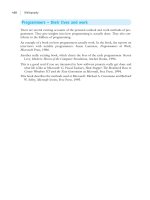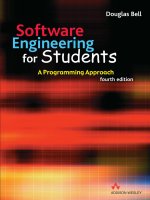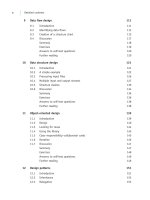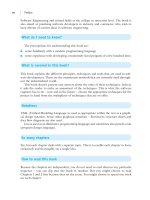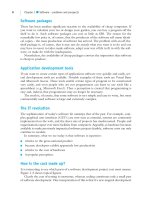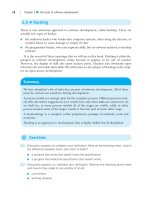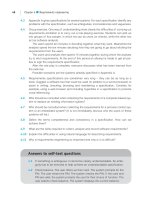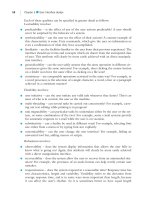Ebook TCPIP essentials A LabBased approach Part 1
Bạn đang xem bản rút gọn của tài liệu. Xem và tải ngay bản đầy đủ của tài liệu tại đây (613.38 KB, 134 trang )
This page intentionally left blank
TCP/IP Essentials
The TCP/IP family of protocols have become the de facto standard in the world of
networking, are found in virtually all computer communication systems, and form the
basis of today’s Internet. TCP/IP Essentials is a hands-on guide to TCP/IP technologies,
and shows how the protocols operate in practice. The book contains a series of carefully
designed and extensively tested laboratory experiments that span the various elements of
protocol definition and behavior. Topics covered include bridges, routers, LANs, static
and dynamic routing, multicast and realtime service, and network management and
security. The experiments are described in a Linux environment, with parallel notes on
Solaris implementation. The book includes many exercises, and supplementary material
for instructors is available. The book is aimed at students of electrical and computer
engineering or computer science who are taking courses in networking. It is also an ideal
guide for engineers studying for networking certifications.
Shivendra S. Panwar is a professor in the Electrical and Computer Engineering
Department at Polytechnic University, Brooklyn, New York, USA. He is currently the
Director of the New York State Center for Advanced Technology in Telecommunications
(CATT). He is the author of over 80 refereed papers.
Shiwen Mao is a research associate in the Bradley Department of Electrical and
Computer Engineering, Virginia Polytechnic Institute and State University, Blacksburg,
VA, USA.
Jeong-dong Ryoo is a senior member of research staff at the Electronics and
Telecommunications Research Institute, Daejon, South Korea.
Yihan Li is a research associate in the Department of Electrical Engineering,
Polytechnic University, Brooklyn, New York, USA.
TCP/IP Essentials
A Lab-Based Approach
Shivendra S. Panwar
Department of Electrical and Computer Engineering,
Polytechnic University, Brooklyn, New York
Shiwen Mao
The Bradley Department of Electrical and Computer Engineering,
Virginia Polytechnic Institute and State University
Blacksburg, Virginia
Jeong-dong Ryoo
Electronics and Telecommunications Research Unit,
Daejeon, South Korea
Yihan Li
Department of Electrical and Computer Engineering,
Polytechnic University,
Brooklyn, New York
CAMBRIDGE UNIVERSITY PRESS
Cambridge, New York, Melbourne, Madrid, Cape Town, Singapore, São Paulo
Cambridge University Press
The Edinburgh Building, Cambridge CB2 8RU, UK
Published in the United States of America by Cambridge University Press, New York
www.cambridge.org
Information on this title: www.cambridge.org/9780521841443
© Cambridge University Press 2004
This publication is in copyright. Subject to statutory exception and to the provision of
relevant collective licensing agreements, no reproduction of any part may take place
without the written permission of Cambridge University Press.
First published in print format 2004
ISBN-13
ISBN-10
978-0-511-26472-6 eBook (EBL)
0-511-26472-0 eBook (EBL)
ISBN-13
ISBN-10
978-0-521-84144-3 hardback
0-521-84144-5 hardback
ISBN-13
ISBN-10
978-0-521-60124-5 paperback
0-521-60124-X paperback
Cambridge University Press has no responsibility for the persistence or accuracy of urls
for external or third-party internet websites referred to in this publication, and does not
guarantee that any content on such websites is, or will remain, accurate or appropriate.
To my wife, Shruti, my parents, and Choti.
Shivendra Panwar
To my wife, Kweesook, my children, James and Michelle, and my parents.
Jeong-dong Ryoo
To our son, Eric, and our parents.
Yihan Li and Shiwen Mao
Contents
Preface
Note to instructors
Acknowledgements
General conventions
List of abbreviations
0
TCP/IP overview
0.1
0.2
0.3
0.4
0.5
0.6
0.7
0.8
0.9
0.10
0.11
1
vii
The Internet
TCP/IP protocols
Internetworking devices
Encapsulation and multiplexing
Naming and addressing
Multiple access
Routing and forwarding
Congestion control and flow control
Error detection and control
Header formats of the protocols
An example: how TCP/IP protocols work
together
page xiii
xv
xvi
xvii
xviii
1
1
2
5
7
8
15
16
17
18
19
22
Linux and TCP/IP networking
26
1.1
1.2
1.3
1.4
26
26
31
35
Objectives
Linux and TCP/IP implementations
Linux commands and tools
Diagnostic tools
viii
Contents
1.5
1.6
1.7
2
3
4
Exercises with Linux commands
Exercises with diagnostic tools
Exercises on port numbers
36
39
41
A single segment network
43
2.1
2.2
2.3
2.4
2.5
2.6
2.7
2.8
2.9
43
43
50
52
54
54
55
58
59
Objectives
Local area networks
Network interface
The Internet Control Message Protocol
The Sock traffic generator
Network interface exercises
ARP exercises
Exercises with ICMP and ping
Exercises with IP address and subnets mask
Bridges, LANs and the Cisco IOS
61
3.1
3.2
3.3
3.4
3.5
3.6
3.7
61
61
66
71
73
75
76
Objectives
Ethernet bridges
Configuring a bridge or router
Exercises on Cisco IOS
A simple bridge experiment
Spanning tree exercises
Exercise on the Cisco IOS web browser UI
Static and dynamic routing
77
4.1
4.2
4.3
4.4
4.5
4.6
4.7
77
77
89
90
91
93
95
Objectives
Static and dynamic routing
Manipulating routing tables
Traceroute
A simple router experiment
RIP exercises
Routing experiments with ICMP
ix
Contents
4.8 OSPF exercise
4.9 Static routing experiment
4.10 Traceroute experiment
5
6
7
97
98
99
UDP and its applications
100
5.1
5.2
5.3
5.4
5.5
5.6
5.7
5.8
100
100
101
102
106
106
107
108
Objectives
The User Datagram Protocol
MTU and IP fragmentation
Client–server applications
Using the sock program
UDP exercises
Path MTU discovery exercise
Exercises with FTP and TFTP
TCP study
111
6.1
6.2
6.3
6.4
6.5
6.6
6.7
6.8
6.9
6.10
6.11
6.12
111
111
112
114
123
124
126
127
128
128
129
130
Objectives
TCP service
Managing the TCP connection
Managing the TCP data flow
Tuning the TCP/IP kernel
TCP diagnostic tools
Exercises on TCP connection control
Exercise on TCP interactive data flow
Exercise on TCP bulk data flow
Exercises on TCP timers and retransmission
Other exercises
Exercises with DBS and NIST Net
Multicast and realtime service
134
7.1
7.2
134
134
Objectives
IP multicast
x
Contents
7.3
7.4
7.5
7.6
7.7
8
9
Realtime multimedia streaming
Simple multicast exercises
IGMP exercises
Multicast routing exercises
Multicast video streaming exercise
145
152
154
156
158
The Web, DHCP, NTP and NAT
159
8.1
8.2
8.3
8.4
8.5
8.6
8.7
8.8
8.9
8.10
8.11
159
159
164
169
172
175
178
180
181
182
185
Objectives
The HyperText Transfer Protocol
The Dynamic Host Configuration Protocol
The Network Time Protocol
The IP network address translator
Socket programming in a nutshell
HTTP exercises
DHCP exercises
NTP exercises
NAT exercises
Socket programming exercises
Network management and security
187
9.1
9.2
9.3
9.4
9.5
9.6
9.7
9.8
9.9
9.10
9.11
9.12
9.13
187
187
192
193
198
200
203
205
208
209
210
211
212
Objectives
Network management
Network security overview
Encryption, confidentiality, and authentication
Application layer security
Transport layer and web security
Network layer security
System security
SNMP exercises
Exercises on secure applications
Exercises on a secure Apache server
Exercises on firewalls and iptables
Exercises on auditing and intrusion detection
xi
Contents
References and further reading
214
Appendix A: instructor’s guide
216
A.1
A.2
A.3
A.4
A.5
A.6
216
217
219
229
230
232
Lab operation mechanism
Lab equipment
Software installation and configuration
Estimated budget
Root privilege for system commands
Internet access
Appendix B: initial configuration of the routers
233
B.1 Initial configuration of router1
B.2 Initial configurations of the other routers
233
235
Appendix C: source code
236
C.1
C.2
C.3
C.4
236
239
245
246
Command files for the DBS experiments
Netspy source code
HTML and CGI files
Socket programming source code
Appendix D: list of key requests for comments (RFC)
253
Index
258
Preface
You can know the name of a bird in all the languages of the world, but when
you’re finished, you’ll know absolutely nothing whatever about the bird . . . So
let’s look at the bird and see what it’s doing – that’s what counts. I learned very
early the difference between knowing the name of something and knowing
Richard Feynman (1918–1988)
something.
As the title of this book suggests, this book is a minimalist approach to
teaching TCP/IP using laboratory-based experiments. It is minimalist in
that it provides one, possibly idiosyncratic, choice of topics at a depth
we felt was sufficient to learn the basics of TCP/IP. The intention was
not to write a reference text on the subject. The laboratory was important
in giving students the experience of observing the TCP/IP protocols in
action. The act of observing and drawing some conclusions from those
observations, brings to life the often dry study of network protocols, and
motivates students to learn more about them.
Appendix A is necessary reading only for the instructor who is in charge
of setting up the lab. We have attempted to keep costs down so that only the
most Scrooge-like University administrator would raise an eyebrow over
the cost of the lab equipment (as for lab space, that may be another matter!). We assume that the students have a basic background in networking,
perhaps from a previous course, or perhaps as part of a course that back
loads the experiments in this book after providing a general lecture-based
introduction to networks. Chapter 0 is a quick overview of TCP/IP that
serves two purposes. It provides an overview of the TCP/IP stack, and
serves as the framework for the rest of the book. Chapters 1 to 9 have the
following common structure. Each of them provides introductory material
suitable for presentation in the lecture part of the course followed by a lab
experiment. The lab experiments should follow lectures that provide the
xiii
xiv
Preface
students with the basic knowledge they need to perform the experiments
and derive insights from their observations during the course of the experiments. Each lab experiment is designed to take no more than 3 hours to
complete.
The experiments were developed on the basis of a course taught at
the Polytechnic University over the course of over eight years. Initially,
we used SUN workstations with the Solaris operating system, but have
now switched to Linux machines. The primary operating system in this
book is Linux, but with Solaris commands provided when they differ
from Linux commands. Chapter 1 provides an introduction to Linux,
since many students may be unfamiliar with this operating system. It also
introduces key tools used in subsequent experiments such as tcpdump
and Ethereal. Chapter 2 introduces network interfaces, ping and IP addresses. Chapter 3 introduces bridges, also known as layer two switches,
bridge/router configuration, and the Cisco IOS. Chapter 4 focuses on routing, with RIP and OSPF as the routing protocols studied, along with the
useful traceroute utility. Chapter 5 introduces UDP and FTP. Chapter 6
follows up with TCP, including a study of its congestion control mechanism. These six chapters are sufficient in many cases to introduce students
to the basics of TCP/IP. Nonetheless, the next three chapters are important
for students who wish to link the basic plumbing of TCP/IP with applications. Chapter 7 deals with IP multicast and realtime applications. The
web, DHCP, NTP and NAT are some key applications that are presented
in Chapter 8, as well as a brief introduction to socket programming. Network management and security are arguably two of the most important
features that students need to know, at least at a basic level. Chapter 9
provides a brief introduction to this material, which can easily be the subject of a separate course. A list of key RFCs is provided at the end of the
book.
There are several alternative ways of teaching this material with this
book. A general knowledge of networking is assumed as a prerequisite for
this book. However, an introductory course in networking could be combined with the first six experiments, back-loaded at the end of the course, to
illustrate the lowest four layers of the protocol stack. For computer scientists, a top-down approach is sometimes the preferred approach in teaching
networking. In that case the lab experiments can be re-ordered to focus on
the higher layers.
xv
Preface
Note to instructors
Additional course material, including lecture transparencies, sample lab
reports, homework assignments, examinations, and errata, are available at
the course website: www.cambridge.org/052160124X.
Acknowledgements
The authors would like to acknowledge the support of Polytechnic
University, the National Science Foundation, the New York State Office of
Science, Technology and Academic Research (NYSTAR), and the Securities Industries Automation Corporation (SIAC). In particular, it was our
work with SIAC, a company responsible for the networking and system
needs of the New York and American Stock Exchanges, which initially
inspired us. In particular, we would like to thank Andrew Bach, Joseph
Kubat, Michael Lamberg, Darko Mrakovcic, and Dror Segal of SIAC for
their support. A special thanks to Dr. Nitin Gogate, who helped with the
initial version of the experiments, and all the graduate students who followed. We would like to thank Jeffrey (Zhifeng) Tao, Yanming Shen and Pei
Liu, who helped proofread and test the lab experiments. We would also like
to thank the following faculty members who have also taught this course
over the years at Poly: Malathi Veeraraghavan, John (Zheng-Xue) Zhao,
and Jorg Liebeherr.
xvi
General conventions
The following conventions are used all through this book.
r In paragraphs, Linux, Unix and Cisco IOS commands are written in a
bold font, such as: telnet and enable.
r In a compound command with options and parameters, the command and
options are in bold, while the parameters are in italics. For example, in
tcpdump -enx host ip addr1 and ip addr2,
the command tcpdump uses options -e, -n and -x. In the filter that follows, key words such as host, and, not, or etc., are also in bold. The
parameters are ip addr1 and ip addr2, which should be replaced with
the corresponding IP addresses during the exercise.
The following exemplary command,
/etc/init.d/snmpd start|stop,
uses two options. Either start or stop can be used, but not at the same
time.
r The name of a host or router is in the Typewriter typestyle, e.g., shakti
or Router4.
r A protocol header field is also in the Typewriter typestyle, e.g., Length
or Source IP Address.
r Questions in the Lab report section of each exercise should be answered
in the lab report. For example, for Exercise 1 in Chapter 1, students need
to answer the following question in Lab Report 1.
Lab report What is the default directory when you open a new command
tool? What is your working directory?
r In this guide, we focus on the Linux operating system. However, this
guide can also be used with the Sun Solaris operating system. In the
following text, Linux-specific material, or general material that apply to
both operating systems are used, while the Solaris specific materials are
enclosed between horizontal lines.
xvii
Abbreviations
xviii
ACK
AIMD
API
ARP
ARPA
API
AS
ATM
Acknowledgement
Additive-Increase-Multiplicative-Decrease
Application Programming Interface
Address Resolution Protocol
Advanced Research Projects Agency
Application Programming Interface
Autonomous System
Asynchronous Transfer Mode
BGP
BOOTP
BPDU
BSD
Border Gateway Protocol
Bootstrap Protocol
Bridge Protocol Data Unit
Berkely Software Distribution
CDE
CIDR
CBT
CGI
CRC
CSMA/CA
CSMA/CD
Common Desktop Environment
Classless Interdomain Routing
Core-Based Tree
Common Gateway Interface
Cyclic Redundancy Check
Carrier Sense Multiple Access/Collision Avoidance
Carrier Sense Multiple Access/Collision Detection
DBS
DES
DHCP
DNS
DSS
DVMRP
Distributed Benchmark System
Data Encryption Standard
Dynamic Host Configuration Protocol
Domain Name System
Digital Signature Standard
Distance Vector Multicast Routing Protocol
xix
Abbreviations
EGP
Exterior Gateway Protocol
FDDI
FEC
FIN
FTP
Fiber Distributed Data Interface
Forward Error Correction
Finish Flag
File Transfer Protocol
GPS
Global Positioning System
HTML
HTTP
HyperText Markup Language
HyperText Transfer Protocol
IAB
ICANN
ICMP
IETF
IGP
IGMP
InterNIC
IP
IRTF
ISOC
ISN
Internet Architecture Board
Internet Corporation for Assigned Names
and Numbers
Internet Control Message Protocol
Internet Engineering Task Force
Interior Gateway Protocol
Internet Group Management Protocol
Internet Network Information Center
Internet Protocol
Internet Research Task Force
Internet Society
Initial Sequence Number
LAN
LSA
Local Area Network
Link State Advertisement
MAC
MAC
MIB
MOSPF
MPLS
MSL
MSS
MTU
Medium Access Control
Message Authentication Code
Management Information Base
Multicast Extension to OSPF
Multiprotocol Label Switching
Maximum Segment Life
Maximum Segment Size
Maximum Transmission Unit
xx
Abbreviations
NAT
NFS
NIST
NTP
Network Address Translator
Network File System
National Institute of Standards and Technology
Network Time Protocol
OSPF
Open Shortest Path First
PAT
PDA
PDU
PIM
PNG
PPP
Port Address Translation
Personal Digital Assistant
Protocol Data Unit
Protocol Independent Multicast
Portable Network Graphics
Point-to-Point Protocol
QoS
Quality of Service
RIP
RARP
RBAC
RFC
RPC
RRQ
RSA
RST
RTO
RTCP
RTP
RTSP
RTT
Routing Information Protocol
Reverse Address Resolution Protocol
Role-Based Access Control
Request for Comments
Remote Procedure Call
Read Request
Rivest–Shamir–Adleman
Reset Flag
Retransmission Timeout
Realtime Transport Control Protocol
Realtime Transport Protocol
Real Time Streaming Protocol
Round-Trip Time
SACK
SHA
SIP
SMI
SMTP
SNMP
SPF
Selective Acknowledgment
Secure Hash Algorithm
Session Initiation Protocol
Structure of Management Information
Simple Mail Transfer Protocol
Simple Network Management Protocol
Shortest Path First
xxi
Abbreviations
SSL
STDIN
STDOUT
SYN
Secure Sockets Layer
Standard Input
Standard Output
Synchronize Sequence Number Flag
TCP
TE
TFTP
TTL
Transmission Control Protocol
Traffic Engineering
Trivial File Transfer Protocol
Time-to-Live
UDP
UI
User Datagram Protocol
User Interface
VoIP
VPN
Voice over IP
Virtual Private Network
WAN
Wi-Fi
WWW
Wide Area Network
Wireless Fidelity
World Wide Web
0
TCP/IP overview
From these assumptions comes the fundamental structure of the Internet: a
packet switched communications facility in which a number of distinguishable
networks are connected together using packet communications processors called
gateways which implement a store and forward packet forwarding algorithm.
David D. Clark
0.1 The Internet
The Internet is a global information system consisting of millions of computer networks around the world. Users of the Internet can exchange email,
access to the resources on a remote computer, browse web pages, stream
live video or audio, and publish information for other users. With the evolution of e-commerce, many companies are providing services over the
Internet, such as on-line banking, financial transactions, shopping, and online auctions. In parallel with the expansion in services provided, there has
been an exponential increase in the size of the Internet. In addition, various
types of electronic devices are being connected to the Internet, such as cell
phones, personal digital assistants (PDA), and even TVs and refrigerators.
Today’s Internet evolved from the ARPANET sponsored by the
Advanced Research Projects Agency (ARPA) in the late 1960s with only
four nodes. The Transmission Control Protocol/Internet Protocol (TCP/IP)
protocol suite, first proposed by Cerf and Kahn in [1], was adopted for
the ARPANET in 1983. In 1984, NSF funded a TCP/IP based backbone
network, called NSFNET, which became the successor of the ARPANET.
The Internet became completely commercial in 1995. The term “Internet”
is now used to refer to the global computer network loosely connected
together using packet switching technology and based on the TCP/IP protocol suite.
1
